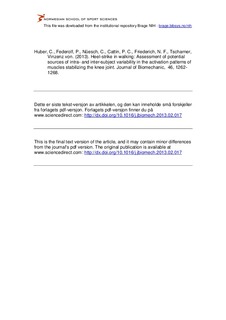| dc.contributor.author | Huber, Cora | |
| dc.contributor.author | Federolf, Peter | |
| dc.contributor.author | Nüesch, Corina | |
| dc.contributor.author | Cattin, Philippe C. | |
| dc.contributor.author | Friederich, Niklaus F. | |
| dc.contributor.author | von Tscharner, Vinzenz | |
| dc.date.accessioned | 2013-10-07T11:12:56Z | |
| dc.date.available | 2013-10-07T11:12:56Z | |
| dc.date.issued | 2013-04-26 | |
| dc.identifier | Seksjon for fysisk prestasjonsevne / Department of Physical Performance | |
| dc.identifier.citation | Journal of biomechanics. 2013, 46, 1262-1268 | no_NO |
| dc.identifier.uri | http://hdl.handle.net/11250/171202 | |
| dc.description | I Brage finner du siste tekst-versjon av artikkelen, og den kan inneholde ubetydelige forskjeller fra forlagets pdf-versjon. Forlagets pdf-versjon finner du på www.sciencedirect.com: http://dx.doi.org/10.1016/j.jbiomech.2013.02.017 / In Brage you'll find the final text version of the article, and it may contain insignificant differences from the journal's pdf version. The definitive version is available at www.sciencedirect.com: http://dx.doi.org/10.1016/j.jbiomech.2013.02.017 | no_NO |
| dc.description.abstract | The electromyographic (EMG) signal is known to show large intra-subject and inter-subject variability. Adaptation to, and preparation for, the heel-strike event have been hypothesized to be major sources of EMG variability in walking. The aim of this study was to assess these hypotheses using a principal component analysis (PCA). Two waveform shapes with distinct characteristic features were proposed based on conceptual considerations of how the neuro-muscular system might prepare for, or adapt to, the heel-strike event. PCA waveforms obtained from knee muscle EMG signals were then compared with the predicted characteristic features of the two proposed waveforms. Surface EMG signals were recorded for ten healthy adult female subjects during level walking at a self-selected speed, for the following muscles; rectus femoris, vastus medialis, vastus lateralis, semitendinosus, and biceps femoris. For a period of 200 ms before and after heel-strike, EMG power was extracted using a wavelet transformation (19–395 Hz). The resultant EMG waveforms (18 per subject) were submitted to intra-subject and inter-subject PCA. In all analyzed muscles, the shapes of the first and second principal component (PC-) vectors agreed well with the predicted waveforms. These two PC-vectors accounted for 50–60% of the overall variability, in both inter-subject and intra-subject analyses. It was also found that the shape of the first PC-vector was consistent between subjects, while higher-order PC-vectors differed between subjects. These results support the hypothesis that adaptation to, and preparation for, a variable heel-strike event are both major sources of EMG variability in walking. | no_NO |
| dc.language.iso | eng | no_NO |
| dc.publisher | Elsevier | no_NO |
| dc.subject | gait | no_NO |
| dc.subject | EMG | no_NO |
| dc.subject | time-frequency analysis | no_NO |
| dc.subject | principal component analysis | no_NO |
| dc.subject | variability | no_NO |
| dc.title | Heel-strike in walking: Assessment of potential sources of intra- and inter-subject variability in the activation patterns of muscles stabilizing the knee joint | no_NO |
| dc.type | Journal article | no_NO |
| dc.type | Peer reviewed | no_NO |
| dc.subject.nsi | VDP::Technology: 500 | no_NO |
| dc.identifier.doi | 10.1016/j.jbiomech.2013.02.017 | |
